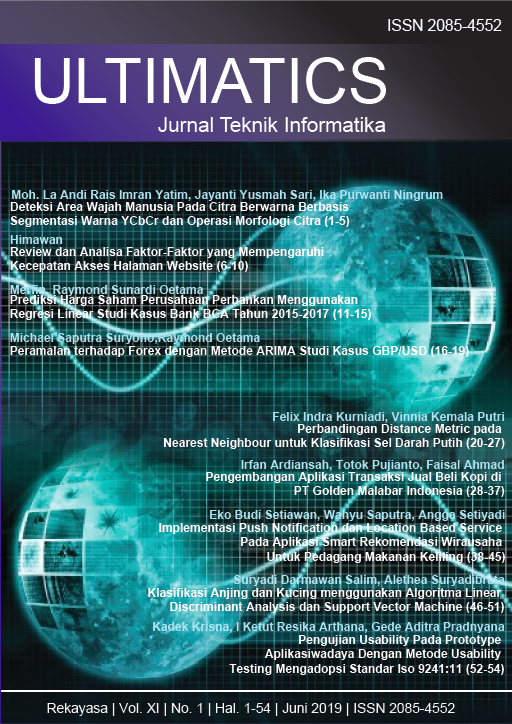Klasifikasi Anjing dan Kucing menggunakan Algoritma Linear Discriminant Analysis dan Support Vector Machine
DOI:
https://doi.org/10.31937/ti.v11i1.1076Abstract
One of the factors driving technological development is the increase in computers ability to complete various jobs. One of them is doing image processing, which is widely used in our daily life, such as the use of fingerprints, face/iris recognition barcodes, medical needs, and various other uses. Classification is one of the applications of image processing that is used the most. One algorithm that can be used for the development of image classification systems is Linear Discriminant Analysis (LDA) and Support Vector Machine (SVM). LDA is a feature extraction algorithm to find a subspace that separates classes well. SVM is a classification algorithm, based on the idea of finding a hyperplane that best divides a dataset into classes. In this study, LDA and SVM algorithms were tested on the dog and cat classification system, with the highest F-score calculation results being 0.69 with 200 training data and 50 testing data for cats and 0.64 with 200 training data and 30 testing data for dogs.
Downloads
Downloads
Published
How to Cite
Issue
Section
License
Authors retain copyright and grant the journal right of first publication with the work simultaneously licensed under a Creative Commons Attribution-ShareAlike International License (CC-BY-SA 4.0) that allows others to share the work with an acknowledgement of the work's authorship and initial publication in this journal.
Authors are able to enter into separate, additional contractual arrangements for the non-exclusive distribution of the journal's published version of the work (e.g., post it to an institutional repository or publish it in a book), with an acknowledgement of its initial publication in this journal.
Copyright without Restrictions
The journal allows the author(s) to hold the copyright without restrictions and will retain publishing rights without restrictions.
The submitted papers are assumed to contain no proprietary material unprotected by patent or patent application; responsibility for technical content and for protection of proprietary material rests solely with the author(s) and their organizations and is not the responsibility of the ULTIMATICS or its Editorial Staff. The main (first/corresponding) author is responsible for ensuring that the article has been seen and approved by all the other authors. It is the responsibility of the author to obtain all necessary copyright release permissions for the use of any copyrighted materials in the manuscript prior to the submission.















